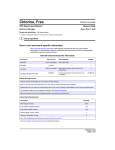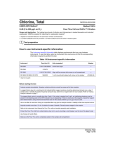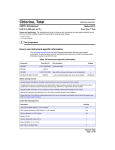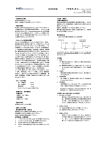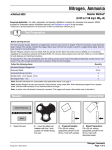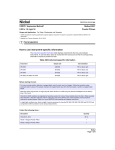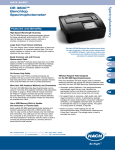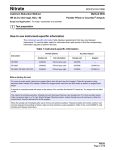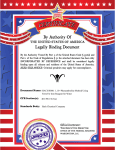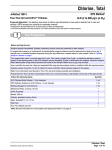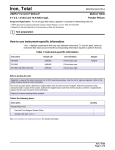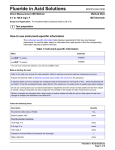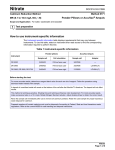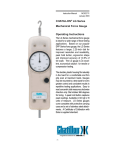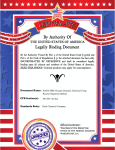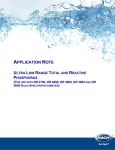Download Manual - Hach Chlorophosphonazo Indicator Solution
Transcript
Hardness, Total, 8374 Hardness, Total DOC316.53.01045 Calcium and Magnesium; Chlorophosphonazo Rapid Liquid Method Method 8374 ULR (4 to 1000 µg/L Ca and Mg as CaCO3) Pour-Thru Cell Scope and Application: For boiler and ultra pure water. Test preparation How to use instrument-specific information The Instrument-specific information table displays requirements that may vary between instruments. To use this table, select an instrument then read across to find the corresponding information required to perform this test. Table 163 Instrument-specific information Instrument Pour-thru Kit DR 6000 LQV175.99.20002 DR 5000 LZV479 DR 3900 DR 3800, DR 2800, DR 2700 Cell orientation Adapter Arrow faces right — — — LQV157.99.10002 Align cell flow arrows with arrows on cell compartment — 5940400 1-inch (round) path aligned with arrow on the adapter LZV585 (B) Before starting the test: Pre-clean the Pour-Thru Cell and all labware as specified in Treating analysis labware. For the most accurate magnesium test results, keep the sample temperature between 21–29 °C (70–84 °F). The test will detect any calcium or magnesium contamination in the mixing cylinder, measuring droppers, or sample cells. To test cleanliness, repeat the test until results are consistent. Protect the Pour-Thru Cell from contamination when not in use by inverting a small beaker over the top of the glass funnel. If the sample concentration is greater than 750 µg/L, a 1:1 dilution of the sample is recommended for greatest accuracy. Use ultra-pure (aldehyde-free) water for the dilution. Repeat the analysis on the diluted sample and multiply the resulting concentration by two. Alternate forms should only be used when the sample is known to contain only Mg or Ca. This method does not distinguish between the two forms. Refer to the instrument User Manual for Pour-Thru cell and module assembly and installation. Use dedicated plasticware for this analysis. In bright light conditions (e.g. direct sunlight) it may be necessary to close the DR 2800 or DR 2700 cell compartment with the protective cover during measurements. Total hardness in mg/L equals mg/L Ca as CaCO3 plus mg/L Mg as CaCO3. Ensure the pour-thru cell is completely seated in the sample cell compartment. Hardness, Total Page 1 of 6 Hardness, Total Collect the following items: Description Quantity Chlorophosphonazo Indicator Solution 2 mL CDTA Reagent for Ultra Low Range Hardness 1 drop Water, Ultra-pure Varies Cylinder, graduated, 50-mL, poly 1 Dispenser, Adjustable Volume 1 Flask, Erlenmeyer, PMP w/cap, 125-mL 1 Pour-Thru Cell Module (see Instrument-specific information table) 1 See Consumables and replacement items for reorder information. Chlorophosphonazo rapid liquid method Stored Programs 227 Hardness Tot RL ULR Start 1. Select the test. Insert an adapter if required (Instrumentspecific information). 5. Fill the rinsed cylinder to the 50-mL mark with sample from the flask. Discard remaining contents of the flask. Hardness, Total Page 2 of 6 2. Flush the Pour-Thru Cell with 50 mL of ultrapure water. 3. Fill a clean, 125-mL plastic Erlenmeyer flask to overflowing with sample. 4. Rinse a clean, 50-mL plastic graduated cylinder three times with sample. Collect sample directly in the flask if possible. 6. Pour the contents of the 50-mL cylinder back into the flask. 7. Add 2.0 mL of Chlorophosphonazo Reagent to the sample with the Dispenser. Swirl to mix. 8. Pour approximately half (25 mL) of the sample into the Pour-Thru Cell. Use a clean, dry, plastic 25-mL graduated cylinder to measure the sample. Hardness, Total Chlorophosphonazo rapid liquid method (continued) Zero 9. After the flow stops, ZERO the instrument. The display will show: 0 µg/L CaCO3 Read 10. Add one drop of CDTA Reagent for Ultra Low Range Hardness to the remaining sample in the flask. Swirl to mix. 11. Pour the remaining sample into the Pour-Thru Cell. 12. READ the results in µg/L CaCO3. Complete steps 11 and 12 within one to two minutes. 13. Using a wash bottle, rinse the Pour-Thru Cell with at least 75 mL of ultrapure water immediately after use. Rinse the flask with ultrapure water. Cap when finished. Hardness, Total Page 3 of 6 Hardness, Total Interferences Table 164 Interfering substances Interfering substance Interference level Aluminum Negative interference above 150 µg/L Ammonium No interference at or below 1000 µg/L Copper Positive interference above 250 µg/L Formaldehyde No interference at or below 47,000 µg/L Potassium No interference at or below 1000 µg/L Silicon Positive interference above 1000 µg/L Sodium Negative interference above 79,000 µg/L Treating analysis labware Clean all containers used in this test thoroughly to remove any traces of calcium or magnesium. If possible, use plastic containers for all analysis and storage. Clean containers by normal means, then rinse with ultra-pure (aldehyde-free) water. Fill and soak for 10 minutes with a 1:25 dilution of Chlorophosphonazo Reagent in ultra-pure water. Rinse well with ultra-pure water. Keep containers tightly closed and dedicate them for ULR Hardness only. If containers are rinsed and capped after each use, only occasional soaking is necessary. Fill the Pour-Thru cell with this same mixture of chlorophosphonazo and water and let stand for several minutes. Rinse with ultra-pure water. Avoid contamination of the Chlorophosphonazo Reagent bottle when placing the Repipet dispenser on the bottle. Rinse the inlet tubing and inside of the dispenser cap with copious amounts of ultra-pure water using a wash bottle. Place the inlet tubing into a beaker of ultra-pure water and depress the plunger 10–15 times to rinse the inside of the dispenser. (For best results, pour a small amount of reagent into the beaker of rinse water.) Remove the dispenser from the water and depress the plunger until all of the water has been expelled. Shake off any excess water on the dispenser, place the dispenser on the bottle and tighten. Sample collection, preservation and storage • Do not use glass containers. • Collect samples in clean plastic containers, preferably with screw-type closures. • Rinse containers several times with the water to be analyzed before collecting the final sample. • Seal to avoid contamination during transport. • Analyze as soon as possible. Accuracy check Required for accuracy check: • Calcium Chloride Standard Solution, 50 mg/L (50,000 µg/L) as CaCO3 • TenSette® Pipet and Pipet Tips Standard additions method (sample spike) 1. Prepare a 20,000 µg/L (20 mg/L) CaCO3 standard by pipetting 20 mL of 50 mg/L CaCO3 standard solution into a 50 mL plastic volumetric flask. Dilute the solution with 50 mL of ultrapure water. 2. After reading test results, leave the sample cell (unspiked sample) in the instrument. 3. Select Options>More>Standard Additions from the instrument menu. Hardness, Total Page 4 of 6 Hardness, Total 4. Default values for standard concentration, sample volume and spike volumes can be accepted or edited. Accept the default values then read the unspiked sample measurement. After values are accepted, the unspiked sample reading will appear in the top row. See the user manual for more information. 5. Use the TenSette Pipet to prepare spiked samples: add 0.2 mL, 0.4 mL, and 0.6 mL of the prepared 20,000 µg/L standard to three 50 mL portions of fresh sample. 6. Follow the test procedure for each of the spiked samples, starting with the 0.2 mL sample spike. Measure each of the spiked samples in the instrument. 7. Select GRAPH to view the results. Select IDEAL LINE (or best-fit) to compare the standard addition results to the theoretical 100% recovery. Standard solution method Note: Refer to the instrument user manual for specific software navigation instructions. 1. Using a 0.50 mg/L (500 µg/L as CaCO3) Calcium Chloride Standard Solution, perform the procedure using the standard in place of the sample. 2. To adjust the calibration curve using the reading obtained with the 0.50-mg/L Standard Solution, select Options>More>Standard Adjust from the instrument menu. 3. Turn on the Standard Adjust feature and accept the displayed concentration. If an alternate concentration is used, enter the concentration and adjust the curve to that value. Method performance Program Standard Precision 95% Confidence Limits of Distribution Sensitivity Concentration change per 0.010 Abs change 227 0.500 mg/L Cr6+ 495–505 µg/L 8µg/L Ca Summary of method Calcium and magnesium combine equivalently with the Chlorophosphonazo Indicator to form a colored complex which absorbs light very strongly at 669 nm. One drop of the CDTA reagent breaks up this complex, and the resultant decrease in color is proportional to the amount of calcium and magnesium (as CaCO3) in the sample. Test results are measured at 669 nm. Consumables and replacement items Required reagents Description Chlorophosphonazo Indicator Solution CDTA Reagent for Ultra Low Range Hardness Quantity/Test Unit Catalog number 2 mL 500 mL 2589549 1 drop 10 mL SCDB 2589636 Quantity Unit Catalog number Required apparatus Description Cylinder, graduated, 50 mL, poly 1 each 108141 Dispenser, variable-volume 1 each 2563137 Flask, Erlenmeyer, PMP w/cap, 125 mL 1 each 2089843 Hardness, Total Page 5 of 6 Hardness, Total Recommended standards Description Unit Catalog number 2127716 Calcium Standard Solution, 50 mg/L as CaCO3 946 mL Calcium Standard Solution, 0.50 mg/L as CaCO3 946 mL 2058016 Water, ultra-pure (aldehyde-free) 500 mL 2594649 Unit Catalog number Optional reagents and apparatus Description each 1970001 50/pkg 2185696 Pipet, volumetric, Class A, 20 mL each 1451520 Pipet filler, Safety bulb each 1465100 Flask, volumetric, polypropylene, 50 mL each 1406041 Pipet, TenSette® 0.1–1.0 mL Pipet Tips, for TenSette Pipet 1970001 FOR TECHNICAL ASSISTANCE, PRICE INFORMATION AND ORDERING: In the U.S.A. – Call toll-free 800-227-4224 Outside the U.S.A. – Contact the HACH office or distributor serving you. On the Worldwide Web – www.hach.com; E-mail – [email protected] © Hach Company, 2007, 2010, 2012. All rights reserved. Printed in the U.S.A. HACH COMPANY WORLD HEADQUARTERS Telephone: (970) 669-3050 FAX: (970) 669-2932 Edition 7






